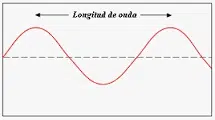The first step we are going to take before beginning to unravel the meaning of the term wavelength is to know the etymological origin of the two main words that give it shape:
-Length, first of all, derives from Latin. Specifically, it comes from “longitudo” which, in turn, emanates from “longus” which means “long”.
-Onda, secondly, we can also indicate that it comes from Latin. In its specific case, it derives from “unda”, which can be translated as “swirl” or “wave”.
In the field of physics , the periodic oscillation that propagates either in a vacuum or in a physical medium is called a wave . The idea of length , on the other hand, refers to the magnitude that reflects the distance that exists between two points.
 Before moving forward with the definition of wavelength , it is important to know some basic questions about waves. A wave is the propagation of a disturbance in the pressure, density, or other property of space , carrying energy but not matter.
Before moving forward with the definition of wavelength , it is important to know some basic questions about waves. A wave is the propagation of a disturbance in the pressure, density, or other property of space , carrying energy but not matter.
The amplitude is the vertical distance recorded between the midpoint of the wave and its crest (the point that is furthest from the rest position). The period , meanwhile, is the time it takes for the wave to make a complete oscillation, while the frequency is the number of times the vibration is repeated per unit of time.
The distance between two consecutive crests is known as the wavelength . The wavelength can also be defined as the separation that is recorded between two corresponding points of undulations that are consecutive.
It is often said that the wavelength is equivalent to the actual distance that the disturbance travels in a certain time . In a graphical representation, we will find the wavelength expressed as the distance between the maximum peaks of a sine curve.
In the case of sound , for example, the wavelength is the distance between two consecutive air particles that are in phase (that is, in the same state of vibration).
In addition to everything indicated, we cannot ignore that on the Spanish radio station Radio Clásica, which belongs to RTVE, there is a program titled: “Longitud dewave”. Fernando Blázquez and Lidia Cossío are the directors and presenters of said space, which revolves around curiosities that relate music, new technologies and even science.
Thus, these radio professionals and their guests have tried to answer questions such as Does listening to Mozart's music really make us more intelligent people? or What are the places in the world that have the best acoustics?, for example.
In the same way, we cannot forget that there is a song that responds precisely to the title “Longitud dewave”. It is a composition by the Barcelona artist Carlos Sadness (1987), who performs pop and indie music. This song was released in 2018 and is part of the album called “Different types of light.”
